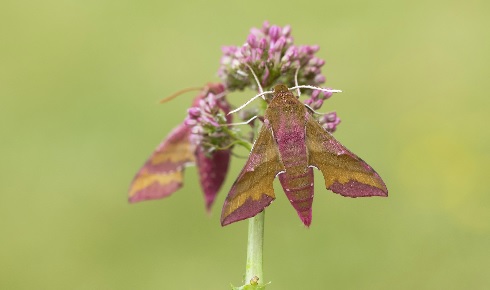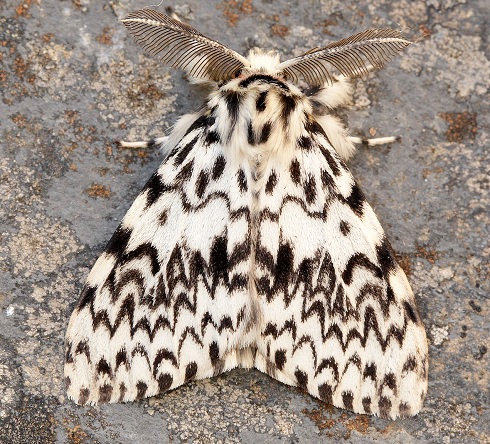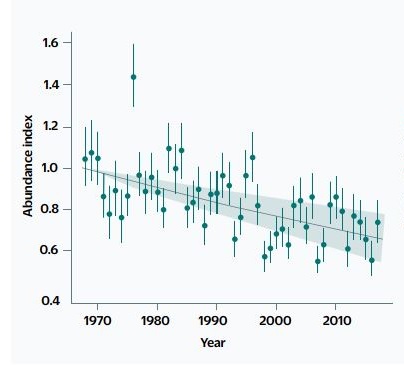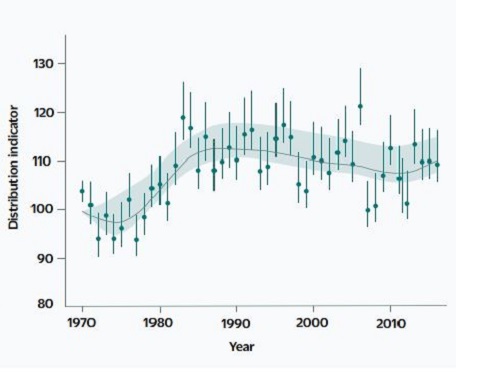Moths on the move

Above: Small elephant hawk moths. Photo by Bob Eade.
A new report from the charity Butterfly Conservation paints a detailed picture of the changing fortunes of the hundreds of moth species in Britain over the last 50 years
September 8th 2021
The world is facing a biodiversity crisis, but the fortunes of insects, which make up at least 60% of all species on Earth and play essential roles in ecosystems, remain poorly understood. Claims of impending ‘insect Armageddon’ have been amplified by the media but savaged by many biologists, who point out that the available data is woefully inadequate to make global assessments[1].
However, British moths are an exception, thanks to millions of moth sightings contributed by volunteers through the National Moth Recording Scheme (NMRS) and to the Rothamsted Insect Survey (RIS), the longest-running standardised monitoring of insect populations in the world.
Any sightings of moths (or their eggs, caterpillars or pupae) anywhere in the UK can contribute to the NMRS and, as a result, this dataset has very broad geographical coverage and is good for assessing the distributions of moths. The RIS, in contrast, is a network of automated light traps that operate every night of the year and can be used to monitor the abundance of nocturnal moths.
 Although black arches (Lymantria monacha) have increased in abundance by 161% (1968–2017), four times as many species have declined in abundance as increased (Credit Iain Leach)
Although black arches (Lymantria monacha) have increased in abundance by 161% (1968–2017), four times as many species have declined in abundance as increased (Credit Iain Leach)Using these datasets, a team of scientists from Butterfly Conservation, Rothamsted Research and the UK Centre for Ecology & Hydrology recently published The State of Britain’s Larger Moths 2021 report[2]. They calculated long-term trends in abundance and distribution for Britain’s larger moths as a whole, and for hundreds of individual species, finding changes in abundance and distribution, and time of emergence, plus over 50 extinctions and more than 100 new colonisations.
In Britain ‘larger moths’ (also known as macro-moths) comprise roughly 900 species in 15 Lepidopteran families, and are traditionally (but arbitrarily) distinguished from other moths and butterflies.
The total abundance of all larger moths caught in the RIS light-trap network in Britain over a 50-year period (1968–2017) decreased significantly by 33% (See Figure 1, below). Splitting the data to produce separate trends for northern and southern Britain revealed significant abundance declines in both regions, but a greater loss in the south (a 39% decrease) than the north (a 22% decrease).
The NMRS distribution data reveals a different overall picture. A multi-species indicator created by combining the individual distribution trends for 511 species showed that, on average, larger moths increased in extent in Britain by 9% over a 47-year period (1970–2016) (See Figure 2, below).
These overall summary measures obscure great variation in the fortunes of individual species over the past five decades. Of 427 widespread species with sufficient RIS data to calculate long-term population trends, 175 species (41% of the total) had decreased significantly, 42 species (10% of the total) had increased significantly and the remaining 210 species (49% of the total) had non-significant trends. Thus, four times as many moth species declined in abundance as increased.
However, more species increased in distribution in Britain than declined since 1970 after variation in recording effort was taken into account. Of a sample of 511 species, 165 species (32%) showed significant distribution declines, while 187 (37% of the total) showed significant increases and 159 species (31%) had non-significant distribution trends.
On average, therefore, enthusiasts and scientists monitoring moth communities may have witnessed an increase in species richness, but a simultaneous, substantial decline in total abundance over the past 50 years. Apart from shedding light on how one group of insects is faring during the unfolding biodiversity crisis, why should we be interested in the state of Britain’s moths? In addition to being beautiful, fascinating creatures, moths play numerous roles in ecosystems.
Moths, and in particular their caterpillars, are essential in the diets of a wide range of predators, including bats and many birds, and act as hosts for a huge diversity of parasitoid flies and wasps. Moth caterpillars are important herbivores, while adult moths have understudied and undervalued roles as pollinators of plants. Recent studies in Britain have revealed that moths transport pollen from a wide variety of plants[3] and some wildflowers, such as orchids, depend on pollination by moths.
 Figure 1: Change in the total abundance of all larger moths caught in the RIS light-trap network in Great Britain and the Isle of Man 1968–2017. The linear trend is a statistically significant decrease of 33%
Figure 1: Change in the total abundance of all larger moths caught in the RIS light-trap network in Great Britain and the Isle of Man 1968–2017. The linear trend is a statistically significant decrease of 33% Figure 2: Multi-species indicator of change in distribution of larger moths in Great Britain and the Isle of Man 1970–2016, with smoothed indicator. The long-term trend is a statistically significant increase of 9%
Figure 2: Multi-species indicator of change in distribution of larger moths in Great Britain and the Isle of Man 1970–2016, with smoothed indicator. The long-term trend is a statistically significant increase of 9%Climate change
While the destruction and deterioration of wildlife-rich habitats is considered to be the main driver of declines in Britain’s moths, climate change also seems to be exerting a big influence on species trends. A number of species adapted to cooler climates in northern and western Britain appear to be retreating, including the grey mountain carpet (Entephria caesiata) with an 81% decrease in distribution (1970–2016); the red carpet (Xanthorhoe decoloraria) with a 62% decrease; the grey chi (Antitype chi) with a 57% decrease; the autumn green carpet (Chloroclysta miata) with a 38% decrease; and the glaucous shears (Papestra biren) with a 38% decrease.
At the same time many other moth species are expanding northwards, seemingly in response to climate change, with increases in distribution and sometimes also abundance. On average the northern limit of species distributions shifted northwards at a rate of 5km per year from 1995 to 2016, and 71% of 487 larger moth species assessed had spread north.
The Devon carpet (Lampropteryx otregiata), for example, has undergone a rapid range expansion since the 1970s, from south-west Britain northwards to reach southern Scotland. Its distribution has more than doubled (an 118% increase from 1980 to 2016) and its abundance has increased by 526% (1968–2017).
The warming climate is also causing many moth species to emerge earlier in the year compared with the 1970s. For example, the mean flight dates of the grey birch (Aethalura punctulata), great prominent (Peridea anceps) and common Quaker (Orthosia cerasi) have advanced by at least 13 days since the 1970s. Research indicates that early emergence benefits moths that have more than one generation each year in Britain, but not those with a single annual brood[4].
Some moth species, such as the buff arches (Habrosyne pyritoides) and swallow-tailed moth (Ourapteryx sambucaria), which historically only had a single annual generation in Britain, are now having a small second generation in the autumn.
Extinctions and colonisations
Aside from the relatively widespread moths for which long-term trends can be estimated, The State of Britain’s Larger Moths 2021 report also assesses the extinctions and colonisations of moth species and reviews work undertaken to conserve threatened moths.
 The lappet (Gastropacha quercifolia) has seen a 98% decrease in abundance (1968–2017) and a 61% reduction in distribution (1980–2016) (Credit Keith Tailby)
The lappet (Gastropacha quercifolia) has seen a 98% decrease in abundance (1968–2017) and a 61% reduction in distribution (1980–2016) (Credit Keith Tailby)A total of 51 moth species (including micro-moths) are considered to have died out in Britain since 1900. The rapid decline to apparent extinction of once widespread species such as the stout dart (Spaelotis ravida) is particularly alarming given that the causes are often unknown.
In contrast, 137 moth species (including micro-moths) have colonised since 1900 and remain resident in Britain today, 53 of which have become established this century. Some of these colonists have arrived naturally, mainly as a result of climate change enabling them to extend their range from continental Europe. Others have arrived as unintended consequences of the global horticultural trade, unwittingly imported into Britain with plants (both native species and exotics) from around the world.
Across Britain, ambitious projects are under way to prevent the loss of rare and threatened moths. Landscape-scale habitat creation is providing a more secure future for species such as Fisher’s estuarine moth (Gortyna borelii) and the black-veined moth (Siona lineata) in south-east England by increasing the size, connectedness and number of colonies.
Optimising woodland management is benefiting the netted carpet (Eustroma reticulatum) in the Lake District and north Lancashire, and the drab looper (Minoa murinata) in South Wales, by creating suitable habitats for their caterpillar host plants. In Scotland the only remaining UK colony of New Forest burnet (Zygaena viciae) has been safeguarded over the past 30 years by building and maintaining fences to exclude sheep from the remote site.
Looking ahead
Overall, the new report confirms continued rapid change to Britain’s larger moth fauna, but it is a complex picture. While substantial numbers of moths are expanding their distributions and new species colonising our shores, there is also clear evidence of worrying declines, which are likely to have a negative impact on the plants that moths pollinate and the many animals that prey upon moths.
While the precise causes of these declines are not fully understood, conservation action is required now to try to stop the ongoing erosion of moth populations. This will require greatly increased support for wildlife-friendly farming measures such as wide field margins, more hedgerow trees and less frequent hedge cutting, all of which lead to increased abundance and species richness of moths[5,6].
Rewilding of ecologically degraded land, whether in urban parks or on country estates, could also greatly benefit moths and other wildlife – something you could try, in miniature, in a corner of your own garden by allowing the grass to grow long or planting some native wildflowers or shrubs.
- You can read The State of Britain’s Larger Moths 2021 in full on the Butterfly Conservation website here.
Dr Richard Fox is associate director of recording and monitoring at the UK charity Butterfly Conservation and was lead author of The State of Britain’s Larger Moths 2021 report. He led the creation of the National Moth Recording Scheme and has been involved in numerous research papers focused on UK butterflies and moths.
1) Montgomery, G. A. et al. Is the insect apocalypse upon us? How to find out. Biol. Conserv. 241, 108327 (2020).
2) Fox, R. et al. The State of Britain’s Larger Moths 2021. Butterfly Conservation, Rothamsted Research and UK Centre for Ecology & Hydrology, Wareham, Dorset, UK (2021).
3) Macgregor, C. J. et al. Construction, validation, and application of nocturnal pollen transport networks in an agro-ecosystem: a comparison using light microscopy and DNA metabarcoding. Ecol. Entomol. 44, 17–29 (2019).
4) Macgregor, C. J. et al. Climate-induced phenology shifts linked to range expansions in species with multiple reproductive cycles per year. Nat. Commun. 10, 4455 (2019).
5) Froidevaux, J .S. P. et al. Moth responses to sympathetic hedgerow management in temperate farmland. Agri. Ecosyst. Environ. 270–271, 55–64 (2019).
6) Merckx, T. et al. Hedgerow trees and extended-width field margins enhance macro-moth diversity: implications for management. J. Appl. Ecol. 49, 1396–1404 (2012).


